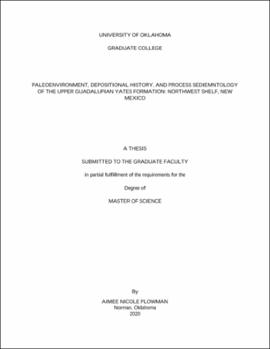| dc.description.abstract | A vertical and lateral outcrop of the late Guadalupian upper Yates Formation is observed along Dark Canyon Road in Eddy County, New Mexico. This outcrop has revealed cyclical, highly dynamic mixed carbonate and siliciclastic packages during the termination of the Yates Formation deposition on the transitional middle to inner shelf region of the Northwest Shelf of the Permian Basin. An integrated XRF, petrographic, grain size analysis, and outcrop field investigation was conducted to determine the paleo-depositional environments and sedimentation mechanisms responsible. Five discrete depositional environments are interpreted based on study: 1) back reef lagoon, 2) subtidal to intertidal algal-dominated flats, 3) hypersaline dolomitic sabkhas, 4) stacked channel fluvial deposits 5) foreshore accretionary beach sands. The observed cyclical, mixed nature of the alternating clastic and carbonate deposits reveals reciprocal sedimentation during frequent fluctuations in sea level. During sea level high stands, carbonate deposition dominated along the platform shelf charactering carbonate facies predominated by heavily algal, fossiliferous packstones and wackestones of a lagoonal shore face bounded by beach shoreface grainstones that graded up into peloidal dolomicrites of a sabkha environment. Clastic deposition of the upper Yates Formation dominated during intermittent low stand times, as falling sea levels gave way to a broad, sub-aerially exposed shelf and a shallow sabkha plain. The sabkha plain was inundated by fluvial channels and streams that carved out and incised wadi channels that lead to imbricated and accretionary stacked channel deposits of transported, fine-grained eolian derived sands. These fluvial channel systems are the primary method of sand transportation bypassing the shelf and reef into the deep Delaware Basin and named as the time equivalent Bell Canyon Sands. Siliciclastic facies are dominated by quartz rich, arkosic, very fine-grained, well sorted, massive sands that are distinctly bounded on the top and bottom by argillaceous siltstone beds which during a relative low stand represent auto-cyclic deposits. Sands of the upper Yates Formation are characterized as primarily eolian in origin and derived from proximal coastal dunes, wind-blown sediment, and/or distal eolian sand provinces that likely existed some distance farther inland. | en_US |
